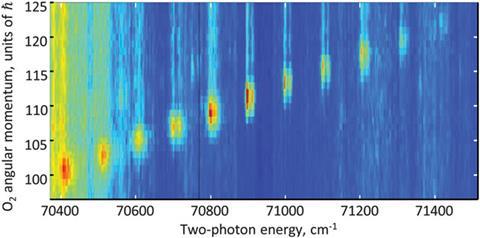A new spectroscopic technique for studying electronically excited molecules at very high angular momentum has been developed and tested by scientists in Canada.
The team, from the University of British Columbia, headed by Valery Milner, have used an optical centrifuge to excite oxygen to rotational states that otherwise can’t be reached. An optical centrifuge combines two laser pulses to create an intense electric field which undergoes angular acceleration to drive molecules into the remarkable angular momentum states. The super rotation state reached for oxygen in the study is equivalent to heating the molecule to 50,000K, a temperature that is too hot for the molecule to survive. A spectroscopic technique called resonance-enhanced multi-photon ionisation was combined with the centrifuge and by carefully controlling and calibrating the rotational speed of the centrifuge a spectrum can be viewed as a two-dimensional function of photon energy and angular momentum.
‘It greatly simplifies the spectra,’ says Aleksey Korobenko, the lead scientist on this study. ‘Even when the photon energy branches are overlapping, you can track one by one the rotational peaks which you can’t otherwise separate out.’

The technique is not limited to observations of the rotational structure of electronic transitions in molecules, as demonstrated in the current study. Molecules excited to the extreme rotational states realisable by using the optical centrifuge are expected to exhibit many intriguing properties, from THz emission, rotation-induced magnetism and macroscopic gas vortices, to unusual surface scattering behaviours and selective bond breaking.
Ilya Averbukh, an expert in laser control and molecular rotation at the Weizmann Institute of Science in Israel, has high hopes for the technique. ‘The approach opens the door for testing our theoretical proposal on using ultra-fast molecular rotation to control molecular scattering from solid surfaces, an area of both fundamental and applied significance. Centrifuge spectroscopy adds an important component to the arsenal of tools required for this study.’
Milner’s group is now applying the technique to two long-term projects. The first is an investigation into fundamental aspects of molecule–surface scattering, in the realm of super rotation, by observing the quantum state distribution of the molecules before and after collision. In the second project they will be controlling and studying molecular rotation inside highly correlated quantum systems, such as superfluid helium.






No comments yet